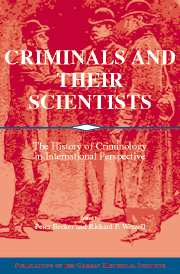Book contents
- Frontmatter
- Introduction
- Part One Nonacademic sites of Nineteenth-Century Criminological Discourse
- Part Two Criminology as Scientific and Political Practice in the Late Nineteenth and Early Twentieth Centuries
- 6 Cesare Lombroso and Italian Criminology: Theory and Politics
- 7 Criminal Anthropology: Its Reception in the United States and the Nature of Its Appeal
- 8 From the “Atavistic” to the “Inferior” Criminal Type: The Impact of the Lombrosian Theory of the Born Criminal on German Psychiatry
- 9 Criminology, Hygienism, and Eugenics in France, 1870-1914: The Medical Debates on the Elimination of “Incorrigible” Criminals
- 10 Crime, Prisons, and Psychiatry: Reconsidering Problem Populations in Australia, 1890-1930
- 11 Positivist Criminology and State Formation in Modern Argentina, 1890-1940
- 12 The Birth of Criminology in Modern Japan
- Part Three The Making of the Criminologist
- Part Four Criminology in the First Half of the Twentieth Century: The Case of Weimar and Nazi Germany
- Index
10 - Crime, Prisons, and Psychiatry: Reconsidering Problem Populations in Australia, 1890-1930
Published online by Cambridge University Press: 05 January 2013
- Frontmatter
- Introduction
- Part One Nonacademic sites of Nineteenth-Century Criminological Discourse
- Part Two Criminology as Scientific and Political Practice in the Late Nineteenth and Early Twentieth Centuries
- 6 Cesare Lombroso and Italian Criminology: Theory and Politics
- 7 Criminal Anthropology: Its Reception in the United States and the Nature of Its Appeal
- 8 From the “Atavistic” to the “Inferior” Criminal Type: The Impact of the Lombrosian Theory of the Born Criminal on German Psychiatry
- 9 Criminology, Hygienism, and Eugenics in France, 1870-1914: The Medical Debates on the Elimination of “Incorrigible” Criminals
- 10 Crime, Prisons, and Psychiatry: Reconsidering Problem Populations in Australia, 1890-1930
- 11 Positivist Criminology and State Formation in Modern Argentina, 1890-1940
- 12 The Birth of Criminology in Modern Japan
- Part Three The Making of the Criminologist
- Part Four Criminology in the First Half of the Twentieth Century: The Case of Weimar and Nazi Germany
- Index
Summary
In the 1890s nearly 1.5 percent of the population of New South Wales (Australia's most populous colony/state) were in prison. By the 1920s this rate had fallen dramatically to only 0.4 percent. This was not merely the effect of a severe economic recession and a subsequent period of growth. Prison admissions in Australia throughout the nineteenth century had been very high, and they declined quickly throughout the first half of the twentieth century. Like so much else in the field of crime, policing, and imprisonment, this trend was hardly unique to Australia. Similar patterns occurred in Britain, Canada, and America, a phenomenon described by Andrew Scull as the first great wave of “decarceration.” This is a misleading concept. When we examine the history of other institutions of “penality” very different patterns emerge. In New South Wales, during the same years of decline in prison admissions, mental hospital residents rose from 0.7 percent to 1.5 percent of the population. In addition, there were no government-run inebriate asylums in 1890 but by 1930 there were two such institutions and many more private institutions. Similarly, in 1890 there was only one asylum for the “mentally defective” but by 1930 there were at least six, and although the numbers admitted to juvenile reformatories had not changed, the number of neglected and delinquent children under some form of state supervision had increased dramatically through the operation of the children's court. What we can see is not so much “decarceration” as diversification, proliferation, and specification, all steps toward an unrealizable but nonetheless powerful ideal of “individualization.”
- Type
- Chapter
- Information
- Criminals and their ScientistsThe History of Criminology in International Perspective, pp. 231 - 252Publisher: Cambridge University PressPrint publication year: 2006
- 2
- Cited by

